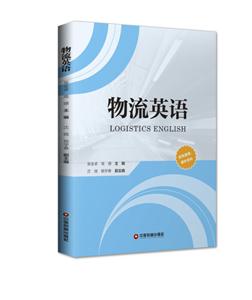-
>
考研英語背單詞20個詞根詞綴
-
>
西班牙語詞根寶典
-
>
美國K-12原版語文課本--初中·下(全12冊)
-
>
流浪地球劉慈欣
-
>
西南聯大英文課 輕讀禮盒版
-
>
英語大書蟲世界經典名譯典藏書系:中國人的精神 (英漢對照)(精選權威版本)
-
>
許淵沖譯唐詩三百首:漢文·英語
物流英語 版權信息
- ISBN:9787504764959
- 條形碼:9787504764959 ; 978-7-5047-6495-9
- 裝幀:平裝-膠訂
- 冊數:暫無
- 重量:暫無
- 所屬分類:>>
物流英語 本書特色
《物流英語》緊密結合物流業發展的新形勢和新特點,系統介紹了物流導論、物流系統(運輸、倉儲、庫存、包裝、裝卸搬運、配送、信息技術)、整合物流管理(物流成本管理、物流質量管理、物流服務管理)、供應鏈管理、商業合同與文檔、國際物流、物流發展新形勢等專業基礎知識,并通過強化培訓,培養和提高讀者的實際操作和應用能力。《物流英語》每一章都包括正文、詞匯與表達,并配有相應的課后習題供學生復習和理解。另外,根據正文內容的不同,還設置了英語情景對話、案例分析、單證制作等學習內容,有利于師生在課堂上的互動,幫助學生提高學習興趣、增強學習效果。《物流英語》可以作為物流工程與物流管理專業和其他相關專業的教學用書,也可供物流研究者及社會從業者閱讀參考。
《物流英語》選材廣泛,以國內外近期出版的教材、期刊和網站資料以及世界知名物流公司的相關資料為基礎,時效性強、內容豐富、材料翔實,具有很強的理論性和實用性。
物流英語 內容簡介
本書緊密結合物流產業發展的特點, 全面系統地介紹了物流英語的相關知識。全書共有七章, 內容涵蓋物流導論、物流系統 (運輸、倉儲、庫存、包裝、裝卸搬運、配送、信息技術) 、整合物流管理 (物流成本管理、物流質量管理、物流服務管理) 、供應鏈管理、商業合同與文檔、國際物流和物流發展新趨勢七大部分。
物流英語 目錄
1.1 Fundamentals
1.1.1 Definition of Logistics
1.1.2 Historical Development of Logistics
1.1.3 Logistics Related Activities
1.1.4 Objectives of Logistics
1.1.5 7R Theory of Logistics
1.2 The Role of Logistics in the Economy and Organizations
1.2.1 Logistics in the Economy- A Macro Perspective
1.2.2 Logistics in the Firm - A Micro Perspective
1.3 Logistics Industry in China
1.3.1 Current Status of the Logistics Industry in China
1.3.2 Types of Logistics Enterprises in China
1.3.3 Logistics Prosperity Index
Exercises
Chapter 2 Logistics Systems
2.1 Transportation
2.1.1 Introduction to Transportation
2.1.2 Modes of Transport
2.1.3 Intermodal Transportation
2.1.4 Containerization
2.2 Warehousing
2.2.1 Introduction to Warehouses
2.2.2 Introduction to Warehousing
2.2.3 Warehousing Operations
2.3 Inventory
2.3.1 Introduction to Inventory
2.3.2 Types of Inventory
2.3.3 Inventory Management
2.4 Packaging
2.4.1 Introduction to Packaging
2.4.2 Common Packaging Materials and Determinants
2.4.3 Packaging Marks
2.5 Handling
2.5.1 Introduction to Handling
2.5.2 Operation Machinery
2.5.3 Material Flow Management
2.6 Distribution
2.6.1 Distribution Channels
2.6.2 Distribution Centers
2.6.3 Distribution Activities
2.7 Information Technology
2.7.1 Information Technology in a Supply Chain
2.7.2 Order Management and Customer Service through Information System
Exercises
Chapter 3 Integrated Logistics Management
3.1 Logistics Cost Management
3.1.1 Introduction
3.1.2 Methods of Logistics Cost Management
3.1.3 Case Study
3.2 Logistics Quality Management
3.2.1 Introduction
3.2.2 Logistics Quality Management Approach
3.2.3 Case Study
3.3 Logistics Service Management
3.3.1 Introduction
3.3.2 Logistics Service Quality Evaluation
3.3.3 Case Study
Exercises
Chapter 4 Supply Chain Management
4.1 Introduction to Supply Chain
4.1.1 What Is A Supply Chain
4.1.2 Decision Phases of A Supply Chain
4.1.3 Process View of A Supply Chain
4.2 Supply Chain Management Methods
4.2.1 Quick Response (QR)
4.2.2 Efficient Consumer Response (ECR)
4.2.3 Activity Based Classification (ABC)
4.2.4 Value Chain Analysis (VCA)
4.3 Supply Chain Drivers and Obstacles
4.3.1 Drivers of Supply Chain Performance
4.3.2 Obstacles to Achieving Strategic Fit
4.3.3 Case Study: Mintendo Game Girl
Exercises
Chapter 5 Business Contracts and Documents
5.1 Business Negotiation
5.1.1 Elemental Procedures of Negotiation
5.1.2 Strategies of Business Negotiation
5.1.3 Basic Principles of Negotiation
5.1.4 Business Letters: Enquiry and Quotation/Offer
5.2 Contract
5.2.1 Introduction to Business Contract
5.2.2 Formation of A Business Contract
5.2.3 Sample Contract Document
5.3 Payment
5.3.1 Payment Instruments
5.3.2 Remittance and Collection
5.3.3 Letter of Credit
Exercises
Chapter6 International Logistics
6.1 Introduction to International Logistics
6.1.1 Definition of International Logistics
6.1.2 Features of International Logistics
6.1.3 The Role of Governments in International Logistics
6.2 International Trade Terminology
6.2.1 WhatAre the Incoterms 2010
6.2.2 Case Study
6.3 International Cargo Transportation
6.3.1 Ocean Transportation
6.3.2 Air Transportation
6.3.3 Railway Transportation
6.3.4 Road Transportation
6.3.5 Multimodal Transportation
6.4 International Cargo Insurance
6.4.1 Maritime Loss
6.4.2 Kinds of Cargo Insurance
6.4.3 Insurance Premium
6.4.4 Insurance Claim
6.4.5 Insurance Policy Document
6.5 International Cargo Warehousing
6.5.1 The Role of International Warehousing
6.5.2 Bonded Warehouse
6.5.3 Bonded Zones and Bonded Warehouses in China
6.6 Customs and Customs Clearance
6.6.1 Introduction
6.6.2 Customs Declaration
6.6.3 Customs Clearance Process for Bonded Goods
6.6.4 Import/Export Duty
6.6.5 Filling in a Declaration Form
6.7 International Cargo Inspection
6.7.1 What Is Inspection
6.7.2 Inspection Time and Places
6.7.3 Inspection Standards
6.7.4 Inspection Institutions
6.7.5 Inspection Certificates
6.8 International Logistics Services
6.8.1 International Freight Forwarding
6.8.2 International Shipping Agency
6.8.3 International Express
Exercises
Chapter 7 New Trends of Logistics
7.1 Green Logistics
7.1.1 Introduction to Green Logistics
7.1.2 Environmental Issues in Logistics
7.1.3 Development and Application of Green Logistics
7.1.4 The Plan for Green Logistics
7.1.5 How to Implement Green Logistics in A Greener Supply Chain
7.2 Third-Party Logistics(3PL)
7.2.1 Introduction to 3PL
7.2.2 3PL Providers
7.2.3 Future Trend of 3PL Industry
7.3 Reverse Logistics
7.3.1 Introduction to Reverse Logistics
7.3.2 The Reverse Logistics Motivators
7.3.3 Reverse Logistics Opportunities and Challenges
Exercises
References
物流英語 節選
Since there are some differences among the definitions, to avoid potential misunderstanding of the meaning of logistics, this book adopts the authoritative definition provided by the Council of Supply Chain Management Professionals(CSCMP, formerly known as Council of Logistics Management), the preeminent worldwide professional association dedicated to the advancement and dissemination of research and knowledge on supply chain management. The definition is as follows: “Logistics is the process of planning, implementing, and controlling the efficient, effective flow and storage of goods, services, and related information from point of origin to point of consumption for the purpose of conforming to customer requirements.” Note that this definition includes inbound, outbound, internal, and external movements, and return of materials for environmental purposes. —Council of Supply Chain Management Professionals
物流英語 作者簡介
吳金卓,畢業于美國西弗吉尼亞大學,現為東北林業大學物流工程專業碩士生導師。先后主持國家科技支撐計劃專題、國家自然科學基金項目,發表SCI、EI檢索學術論文20余篇,發表中文核心論文8篇,發表教改論文2篇。
- >
【精裝繪本】畫給孩子的中國神話
- >
朝聞道
- >
羅曼·羅蘭讀書隨筆-精裝
- >
李白與唐代文化
- >
苦雨齋序跋文-周作人自編集
- >
我從未如此眷戀人間
- >
上帝之肋:男人的真實旅程
- >
唐代進士錄
















